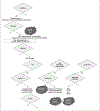Therapies for multidrug resistant and extensively drug-resistant non-fermenting gram-negative bacteria causing nosocomial infections: a perilous journey toward 'molecularly targeted' therapy
- PMID: 29310479
- PMCID: PMC6093184
- DOI: 10.1080/14787210.2018.1425139
Therapies for multidrug resistant and extensively drug-resistant non-fermenting gram-negative bacteria causing nosocomial infections: a perilous journey toward 'molecularly targeted' therapy
Abstract
Non-fermenting Gram-negative bacilli are at the center of the antimicrobial resistance epidemic. Acinetobacter baumannii and Pseudomonas aeruginosa are both designated with a threat level to human health of 'serious' by the Centers for Disease Control and Prevention. Two other major non-fermenting Gram-negative bacilli, Stenotrophomonas maltophilia and Burkholderia cepacia complex, while not as prevalent, have devastating effects on vulnerable populations, such as those with cystic fibrosis, as well as immunosuppressed or hospitalized patients. Areas covered: In this review, we summarize the clinical impact, presentations, and mechanisms of resistance of these four major groups of non-fermenting Gram-negative bacilli. We also describe available and promising novel therapeutic options and strategies, particularly combination antibiotic strategies, with a focus on multidrug resistant variants. Expert commentary: We finally advocate for a therapeutic approach that incorporates in vitro antibiotic susceptibility testing with molecular and genotypic characterization of mechanisms of resistance, as well as pharmacokinetics and pharmacodynamics (PK/PD) parameters. The goal is to begin to formulate a precision medicine approach to antimicrobial therapy: a clinical-decision making model that integrates bacterial phenotype, genotype and patient's PK/PD to arrive at rationally-optimized combination antibiotic chemotherapy regimens tailored to individual clinical scenarios.
Keywords: Gram-negative bacteria; antimicrobial resistance; combination therapy; glucose-non-fermenting; mechanisms of resistance; nosocomial infections; precision medicine.
Figures





References
-
- U.S. Department of Health and Human Services, CDC [Internet]. Atlanta (GA): CDC; c2013. Antibiotic Resistance Threats in the United States [cited 2017 Dec 26] Available from: http://www.cdc.gov/drugresistance/pdf/ar-threats-2013-508.pdf
-
- **. The Review on Antimicrobial Resistance [Internet]. London (UK): O’neill J; c2016. Tackling Drug-Resistant Infections Globally: Final Report and Recommendations [cited 2017 Dec 26] Available from:https://amr-review.org This is a landmark report on the state of antimicrobial resistance worlwdwide. It was commissioned in 2014 U.K. Prime Minister David Cameron and the Wellcome Trust, and led by economist Lord Jim O’Neill.
-
- World Health Organization (WHO) [Internet]. Geneva (Switzerland): WHO; c2015. Draft global action plan on antimicrobial resistance [cited 2017 Dec 26] Available from: http://apps.who.int/iris/bitstream/10665/193736/1/9789241509763_eng.pdf?...
Publication types
MeSH terms
Substances
Grants and funding
LinkOut - more resources
Full Text Sources
Other Literature Sources
Medical
